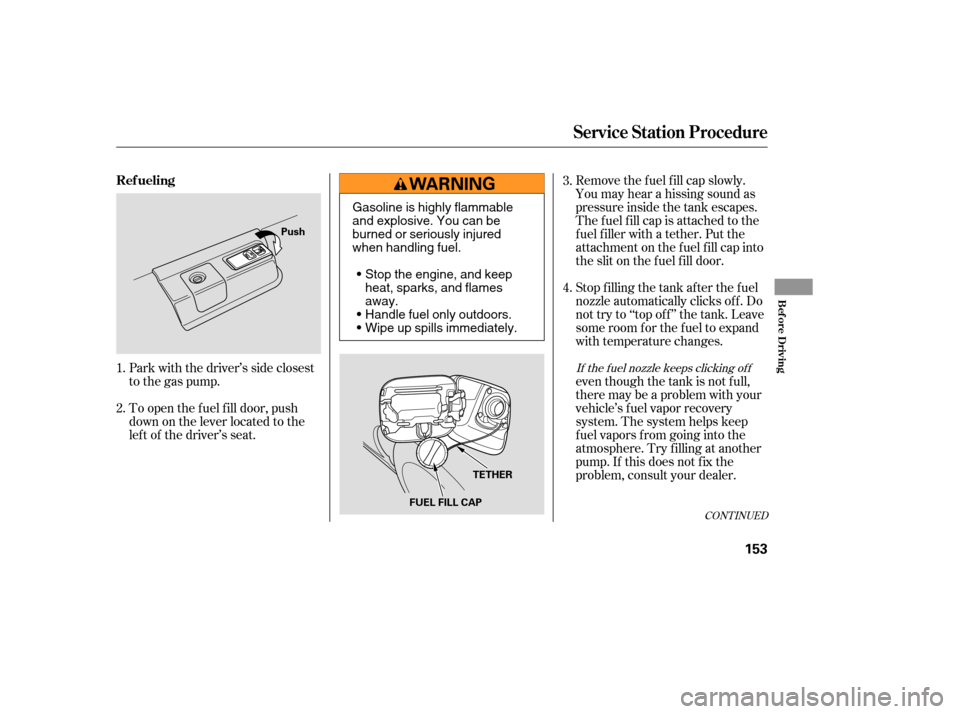Page 67 of 286
When a trip meter is displayed, the
average fuel mileage you have been
getting during that trip is shown in
the Fuel Mileage display. This
number is updated once every ten
seconds.
When you reset a trip meter, the
average fuel mileage for that trip
meter also resets.You can temporarily turn of f the Trip
Mileage display.
Turn the ignition switch to ON (II)
and make sure the transmission is
in Park and the parking brake is
set.
Use the Select/Reset button to
select the odometer display.
Press and hold the Select/Reset
button for about 5 to 10 seconds,
then release it. The Trip Mileage
display will turn of f . The display will turn back on when
you repeat the same procedure in
step 3.
It shows the number of mpg (U.S.)
or l/100 km (Canada).
1.
2.
3.
Inst rument s and Cont rols
Gauges
T rip Mileage T urning Of f the T rip Mileage
Display
66
TRIP METER
�����—�
���—�����y���������������y���
�(���'�������y���������y
Page 70 of 286
This shows how much f uel you have.
It may show slightly more or less
than the actual amount. The needle
returns to the bottom after you turn
of f the ignition. Fuel Gauge
Gauges
Inst rument s and Cont rols
69
Avoid driving with an extremely low
f uel level. Running out of f uel could
cause the engine to misf ire, damaging
the catalytic converter.
�����—�
���—���
�y���������������y���
�(���'�������y���������y
Page 152 of 286

Bef ore you begin driving your
vehicle, you should know what
gasoline to use and how to check the
levels of important f luids. You also
need to know how to properly store
luggage or packages. The
inf ormation in this section will help
you. If you plan to add any
accessories to your vehicle, please
read the information in this section
first..............................
Break-in Period .152
.................
Fuel Recommendation .152
.........
Service Station Procedures .153
....................................
Ref ueling .153
Opening and Closing the
.......................................
Hood .154
...................................
Oil Check .155
.............
Engine Coolant Check .156
...............................
Fuel Economy .157
........
Improving Fuel Economy .157
...
Accessories and Modif ications .158
................................
Accessories .158
...........
Modif ying Your Vehicle .159
.
Additional Safety Precautions .159
.............................
Carrying Cargo .160
................................
Load Limits .161
Carrying Cargo in the Trunk
.................
or on a Roof Rack .162
Carrying Items in the .....
Passenger Compartment .162
Bef ore Driving
Bef ore Driving
151
�����—�
���—���
�y���������������y���
�(���'�������y���
�����y
Page 153 of 286

Help assure your vehicle’s f uture
reliability and perf ormance by paying
extra attention to how you drive
during the f irst 600 miles (1,000 km).
During this period:Avoid full-throttle starts and rapid
acceleration.
Do not change the oil until the
scheduled maintenance time.
Avoidhardbrakingforthefirst
200 miles (300 km).
Do not tow a trailer.
You should also f ollow these
recommendations with an
overhauled or exchanged engine, or
when the brakes are replaced. Your vehicle is designed to operate
on unleaded gasoline with a pump
octane number of 86 or higher. Use
of a lower octane gasoline can cause
a persistent, heavy metallic rapping
noise that can lead to engine damage.
We recommend quality gasoline
containing detergent additives that
help prevent f uel system and engine
deposits.
In addition, in order to maintain good
perf ormance, f uel economy, and
emissions control, we strongly
recommend, in areas where it is
available, the use of gasoline that
does NOT contain manganese-based
f uel additives such as MMT.
Use of gasoline with these additives
may adversely af f ect perf ormance,
and cause the malfunction indicator
lamp on your instrument panel to
come on. If this happens, contactyour authorized dealer f or service.
Some gasoline today is blended with
oxygenates such as ethanol or
MTBE. Your vehicle is designed to
operate on oxygenated gasoline
containing up to 10 percent ethanol
by volume and up to 15 percent
MTBE by volume. Do not use
gasoline containing methanol.
If you notice any undesirable
operating symptoms, try another
service station or switch to another
brand of gasoline.
For f urther important f uel-related
inf ormation, please ref er to your
.
Break-in Period, Fuel Recommendation
Break-in Period Fuel Recommendation
Quick Start Guide
152
�����—���
�—�����y�
������
��
���y���
�(���'�������y���
�����y
Page 154 of 286

Remove the f uel f ill cap slowly.
You may hear a hissing sound as
pressure inside the tank escapes.
The fuel fill cap is attached to the
f uel f iller with a tether. Put the
attachment on the fuel fill cap into
the slit on the f uel f ill door.
Stop f illing the tank af ter the f uel
nozzle automatically clicks of f . Do
not try to ‘‘top of f ’’ the tank. Leave
some room f or the f uel to expand
with temperature changes.
Park with the driver’s side closest
to the gas pump.
To open the f uel f ill door, push
down on the lever located to the
lef t of the driver’s seat. even though the tank is not f ull,
there may be a problem with your
vehicle’s fuel vapor recovery
system. The system helps keep
f uel vapors f rom going into the
atmosphere. Try f illing at another
pump. If this does not f ix the
problem, consult your dealer.
3.
4.
1.
2.
If the f uel nozzle keeps clicking of f
CONT INUED
Ref ueling
Service Station Procedure
Bef ore Driving
153
FUEL FILL CAP
Push
TETHER
Gasoline is highly flammable
and explosive. You can be
burned or seriously injured
when handling fuel.Stop the engine, and keep
heat, sparks, and flames
away.
Handle fuel only outdoors.
Wipe up spills immediately.
�����—�
���—���
�y�����������
���y���
�(���'�������y���
�����y
Page 155 of 286
To Open the Hood:Park the vehicle, and set the
parking brake. Pull the hood
release handle located under the
lower lef t corner of the dashboard.
The hood will pop up slightly.
Screw the fuel fill cap back on
until it clicks at least three times.
If you do not properly tighten the
cap, the Malf unction Indicator
Lampmaycomeon(seepage
).
Push the f uel f ill door closed until
it latches.
Put your f ingers under the f ront
edge of the hood near the center.
Slide your hand to the lef t until
you f eel the hood latch handle.
Push this handle up to release it.
Lif t up the hood.
If the hood latch handle moves stif f ly,
or if you can open the hood without
lifting the handle, the mechanism
should be cleaned and lubricated.
1.
2.
5.
6.
247 Opening and Closing the Hood
Service Station Procedure
154
HOOD RELEASE HANDLE
LATCH
�����—�
���—�����y�
�������������y���
�(���'�������y���
�����y
Page 158 of 286
Always drive in the highest gear
possible.
Try to maintain a constant speed.
Everytimeyouslowdownand
speed up, your vehicle uses extra
f uel. Use cruise control when
appropriate.
Combine several short trips into
one.
The air conditioning puts an extra
load on the engine which makes it
usemorefuel.Usethefresh-air
ventilation when possible.
Always maintain your vehicle
according to the maintenance
schedule. See
(see page
).
Drive moderately. Rapid
acceleration, abrupt cornering,
and hard braking use more f uel. The build-up of snow or mud on
your vehicle’s underside adds
weight and rolling resistance.
Frequent cleaning helps your f uel
mileage and reduces the chance of
corrosion. an underinf lated tire
causes more ‘‘rolling resistance,’’
which uses more f uel. 193
For example,
Improving Fuel Economy
Owner’s
Maintenance Checks
Fuel Economy
Bef ore Driving
157
�����—���
�—�
�
�y�
�
����
������y���
�(���'�������y���
�����y
Page 194 of 286
�µ�µ �µ
�µ
�µ
�µ �µ
Youshouldcheckthefollowing
items at the specif ied intervals. If
you are unsure of how to perf orm
any check, turn to the appropriate
page listed.
Engine oil level Check every
time you fill the fuel tank. See
page .
Engine coolant level Check the
radiator reserve tank every time
you f ill the f uel tank. See page . Brakes Check the f luid level
monthly. See page .
Tires Check the tire pressure
monthly. Examine the tread f or
wear and foreign objects. See page
.
Automatic transmission Check
the f luid level monthly. See pages . Lights Check the operation of
the headlights, parking lights,
taillights, high-mount brake light,
and license plate lights monthly.
155
156
208 209 209
219
Maintenance Schedule
Owner’s Maintenance Checks
Maint enance
193
�����—�
���—���
�y���������������y���
�(���'�������y���
�����y